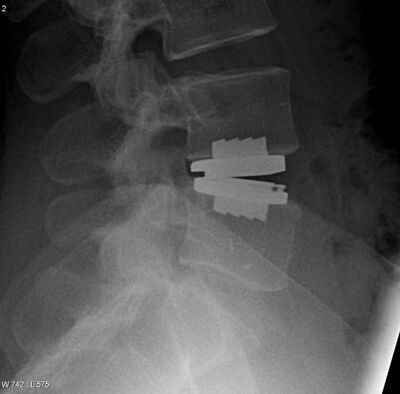Artificial Disc Replacement
Original Editor - Lucinda hampton
Top Contributors - Lucinda hampton
Introduction[edit | edit source]
Artificial disc replacement is an modern procedure that is gaining popularity in spine surgery.[1] The first lumbar artificial disc replacement was in in the late 1950s. Most of the current available artificial disc replacement devices attempt to copy the biomechanics of an intact spinal motion segment, however replacement techniques for the the nucleus disc replacement are only being now developed.[2]
Lumbar disk replacement involves replacing a worn or degenerated disk in the spine with an artificial disk made of metal or a combination of metal and plastic. Commonly the surgery is performed with an anterior incision of the abdomen at the level of the target disc. Recent research reported that lumbar disc arthroplasty had clinical success rates of 76.9% and satisfaction rates of 87.2% at 10-year follow-up, highlighting that a strict patient selection process is mandatory for success.[3]
The usual reason for lumbar disc arthroplasty is lumbar spinal pain that is present due to degenerative disc disease and conservative therapy has proved to be unsuccessful. Lumbar disc arthroplasty is less frequently used than lumbar fusion as it has more contraindications eg osteoporosis or osteopaenia, spinal stenosis or spinal deformities such as scoliosis.[4]
Rehabilitation[edit | edit source]
Usually patients can stand and walk by the first day after surgery. Each surgeons will set their own instructions regarding limitations.
Basic exercises initially iclude eg including routine walking and stretching. Exercise programmes that starting four to six weeks postsurgery are more deficient in decreasing pain and disability than no treatment, with high‐intensity exercise programmes leading to a slightly faster decrease in pain and disability than low‐intensity programmes. No evidence suggests that these active programmes increase the reoperation rate or that patients need to have their activities restricted after first‐time lumbar disc surgery.[5]
Viewing[edit | edit source]
References[edit | edit source]
- ↑ Othman YA, Verma R, Qureshi SA. Artificial disc replacement in spine surgery. Annals of translational medicine. 2019 Sep;7(Suppl 5).Available: https://www.ncbi.nlm.nih.gov/pmc/articles/PMC6778281/ (accessed 12.1.2024)
- ↑ Salzmann SN, Plais N, Shue J, Girardi FP. Lumbar disc replacement surgery—successes and obstacles to widespread adoption. Current reviews in musculoskeletal medicine. 2017 Jun;10:153-9. Available: https://www.ncbi.nlm.nih.gov/pmc/articles/PMC5435628/(accessed 12.1.2024)
- ↑ Saifi C, Cazzulino A, Park C, Laratta J, Louie PK, Shillingford JN, Lehman Jr R, An H, Phillips F. National trends for primary and revision lumbar disc arthroplasty throughout the United States. Global spine journal. 2018 Apr;8(2):172-7.Available:https://orthoinfo.aaos.org/en/treatment/artificial-disk-replacement-in-the-lumbar-spine/ (accessed 13.1.2024)
- ↑ Radiopedia Lumbar disc arthroplasty Available: https://radiopaedia.org/articles/lumbar-disc-arthroplasty?lang=us(accessed 12.1.2024)
- ↑ Oosterhuis T, Costa LO, Maher CG, de Vet HC, van Tulder MW, Ostelo RW. Rehabilitation after lumbar disc surgery. Cochrane Database of Systematic Reviews. 2014(3).Available:https://www.ncbi.nlm.nih.gov/pmc/articles/PMC7138272/ (accessed 13.1.2024)
- ↑ The London Spine Unit. How quick is the recovery after Lumbar Disc Replacement Surgery?. Available from: https://www.youtube.com/watch?v=aJooumuAPHQ [last accessed 13.1.2024]







